人教版B4 Unit 4 Body language Reading课件54张
文档属性
| 名称 | 人教版B4 Unit 4 Body language Reading课件54张 |  | |
| 格式 | zip | ||
| 文件大小 | 5.1MB | ||
| 资源类型 | 教案 | ||
| 版本资源 | 人教版(新课程标准) | ||
| 科目 | 英语 | ||
| 更新时间 | 2015-05-22 08:52:05 | ||
图片预览



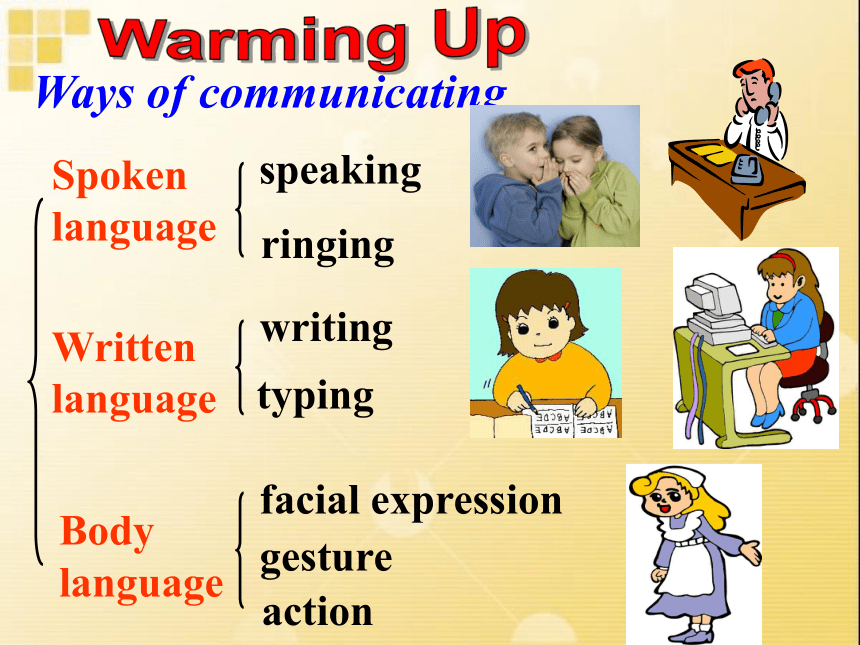
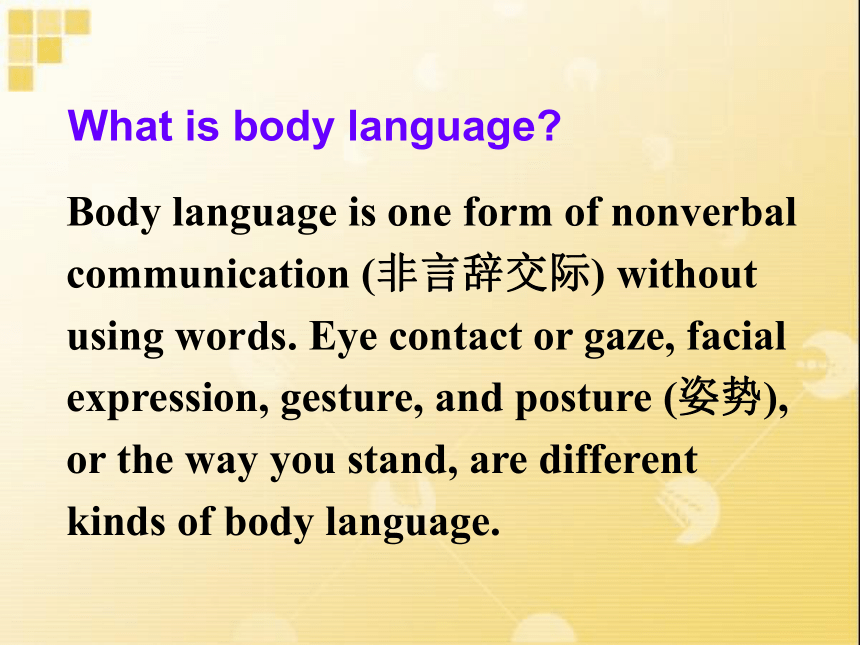
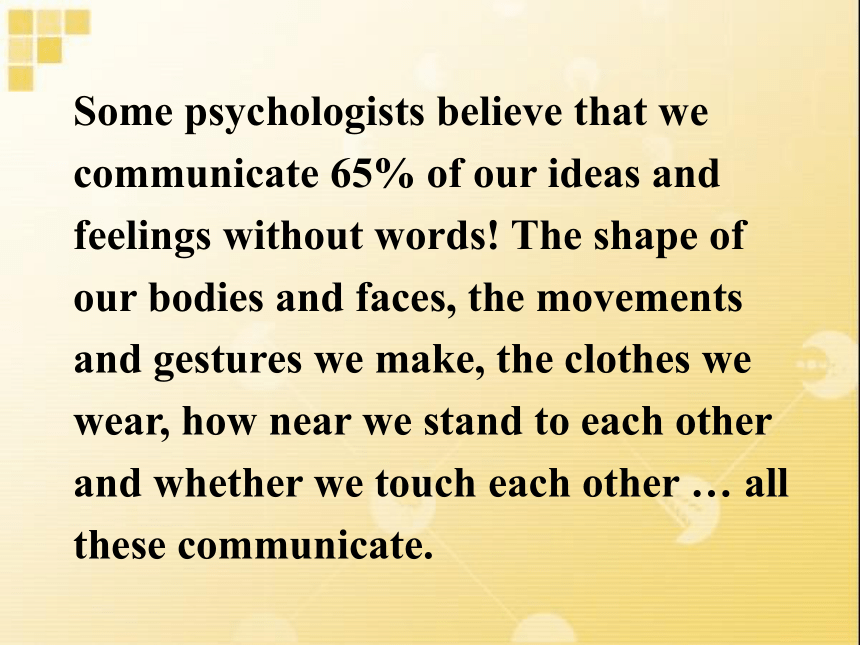
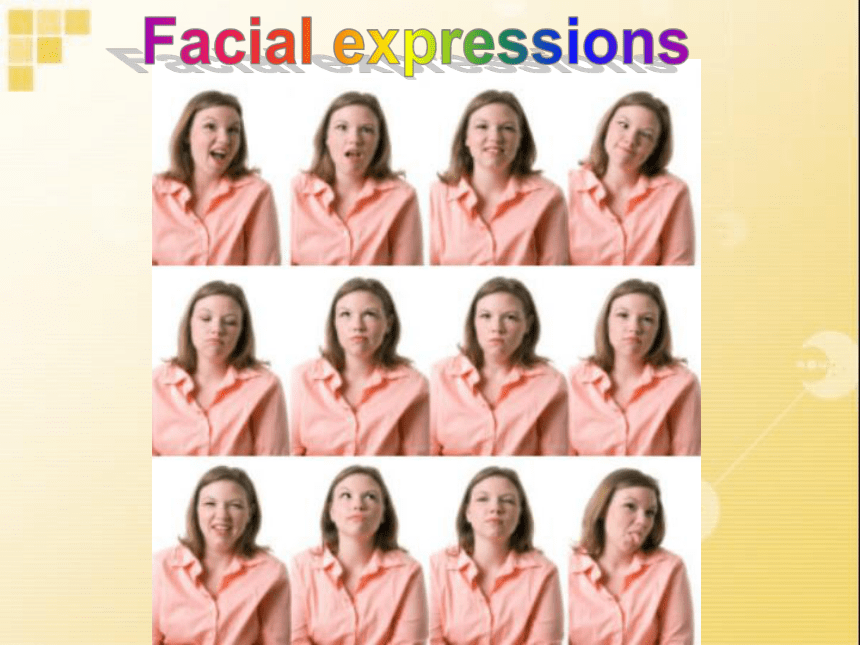
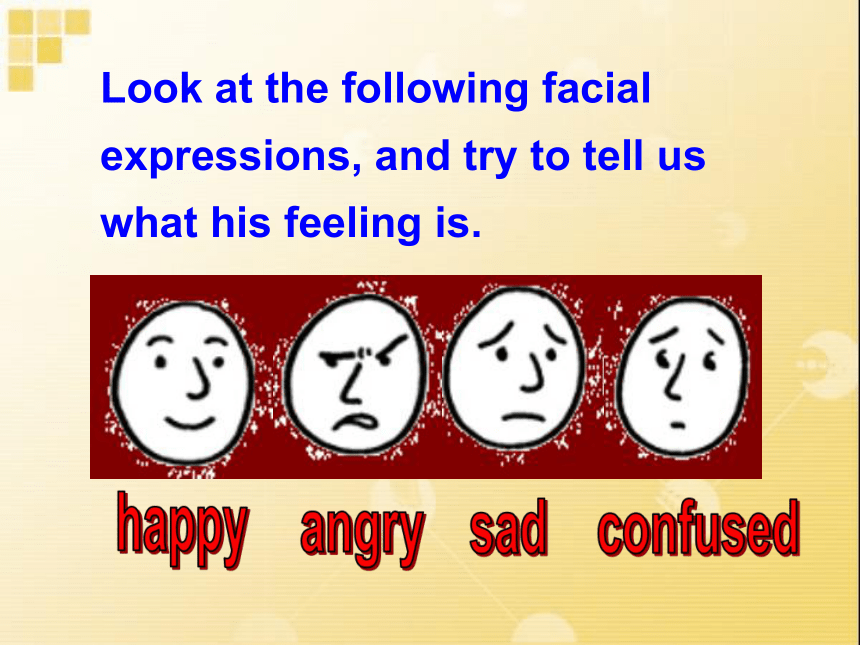
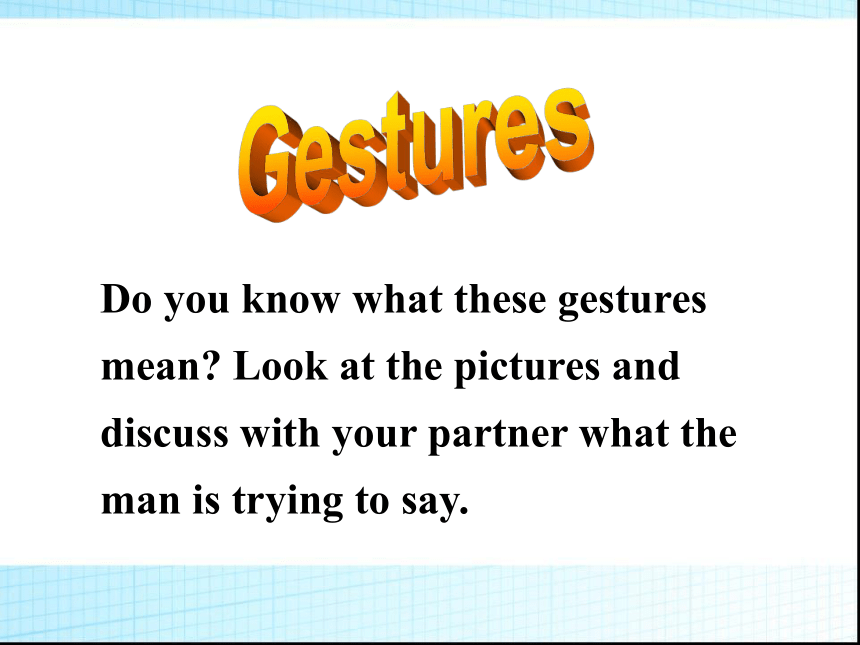

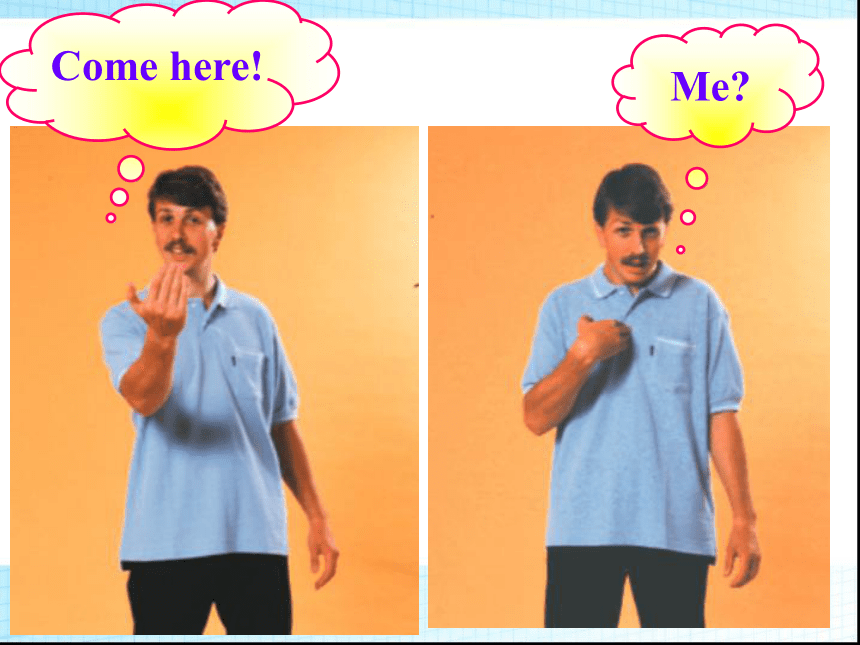
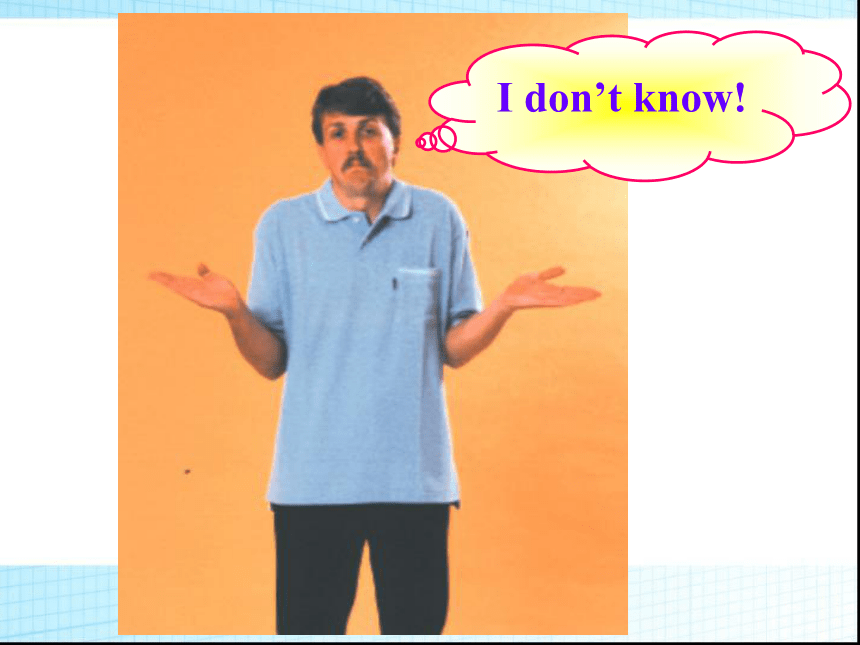
文档简介
课件54张PPT。人教课标
高一 必修4
Unit 4Unit 4
Body languageReadingspeakingringingwritingtypingSpoken
languageWritten
languageBody
languageWays of communicatinggesturefacial expressionactionWarming UpWhat is body language?Body language is one form of nonverbal communication (非言辞交际) without using words. Eye contact or gaze, facial expression, gesture, and posture (姿势), or the way you stand, are different kinds of body language.Some psychologists believe that we communicate 65% of our ideas and feelings without words! The shape of our bodies and faces, the movements and gestures we make, the clothes we wear, how near we stand to each other and whether we touch each other … all these communicate. Facial expressionsLook at the following facial expressions, and try to tell us what his feeling is.happyangrysad confusedGesturesDo you know what these gestures mean? Look at the pictures and discuss with your partner what the man is trying to say.Good!Bad!Come here!Me?I don’t know!okstopsilentwell doneWhat else gestures do you know?victoryapplauseWork in groups.Look at the following pictures. What are these people communicating? Discuss your ideas with your group members. Do you have the same idea about each picture?What are they communicating?The mother is trying to quiet her crying child. Someone is thinking deeply. Someone is feeling ill/having a stomachache. The policeman is directing traffic/ telling cars to go. Read the following statements. Choose a phrase and act it out without speaking. Can your partner guess what you are trying to communicate?“Hello” “Goodbye” “Come here”
“Go away!” “Expensive!”
“I’m surprised!” “I’m tired.”
“I’m confused.” “OK!”“Good luck!” “I’m delighted!”
“I’m upset!” “I’m sad!”
“I forgot!” “You’re great!”Communication:
No problem?Pre-reading1. What is the purpose of language?
The purpose of language is to
communicate with other people. 2. How can you communicate with
someone if you cannot speak? Give
an example.
I can use body language to
communicate with someone if I
can’t speak.For example, if I’m angry, I might turn away and not talk to others. If I’m happy to see someone, I might smile and hold out my hand or open my arms.3. There are many different ways to
greet someone using words. How
many ways can you think of to
greet someone if you cannot speak? Ways to greet someone without words:
smile, wave, shake hands, hug, kiss, etc.handshake kissbowhugPredictingLook at the picture and the title of the passage on page 26.
What do you think the topic will be?I. Read the passage and divide the
whole passage into several parts
and find out the main idea.Part 1. (Para. 1)Meet the visitors at the airport.First-readingPart 2 (Para. 2 and 3)People from different countries express greetings in different ways.Part 3. (Para. 4) Different peoples have different body languages.Part 4. (Para. 5) Summary of body language.Try to write down the main idea of the text.
The text is mainly about different _____________ in different countries. In order to avoid difficulties in today’s world of cultural crossroads, we should ___________________________. body languagestudy international customsRead the passage again and choose the best answers.Second-reading1. In which of the following countries do people greet each other in the same way?
A. Jordan and Italy.
B. China and Japan.
C. Canada and Colombia. 2. From the text, we can know that _____.
A. people are likely to keep the same
distance in different countries
B. men from Britain often stand close
to others to shake hands
C. people are facing multicultural
communication problemsHow do different international
students behave when they greet
people? Complete the chart with
information from the passage.Careful readingman from Colombiakiss on the cheekJulia Smithwoman from BritaineveryoneAkira Nagatabowing everyoneman from Canada shaking handseveryoneAhmed Aziz man from Jordanshaking hands
noddingDarlene Coulonwoman from Francepeople she knows shake hands, do not stand very close to others or touch strangers when they meetshake handsbowapproach others closely
and are more likely to
touch themshake hands and kiss each other twice on each cheekshake hands and stand quite close to other men, nod to women and do not shake hands with them1. Is the author of this passage male or female? How do you know?
The author is male. Ahmed Aziz will not shake hands with women, but he shakes hands with the author.I. Answer the following questions.Post-reading 2. What were the two mistakes that the
author noticed?
He noticed that the Colombian man
kissed the British woman, but in her culture, a kiss from a stranger is not acceptable. He also noticed that the Japanese man bowed just as the Canadian man started to shake hands, so one man’s nose touched the other man’s hand. 3. Who seemed to prefer to keep more physical distance from others? Who seemed to prefer closer physical distance?The British woman, Julia, and probably
the Canadian man, George, seemed to
prefer to keep more physical distance from others. The Colombian man, Tony, and the Jordanian man, Ahmed, seemed to prefer closer physical distance. 4. Did any students have similar greeting customs? If so, which ones?
Yes. Tony from Colombia and Darlene from France had a similar greeting custom—a kiss. George from Canada and Ahmed from Jordan also had a similar greeting custom—a handshake, but Ahmed shakes hands only with men.5. “When in Rome, do as the Romans do.” What do you think this famous saying means?
This saying means that when we are in a certain place, we should follow the customs of the people who live in that place, not our own customs.1. Englishmen often stand close to others or touch strangers as soon as they meet.
2. Most people around the world now greet each other by kissing.II. Decide if the following statements
are true (T) or false (F). FF3. Japanese will bow to others as greeting.
4. People from Jordan will move very
close to you as you introduce yourself to
them.
5. Some body languages in some countries
are good while some countries’ body
language are bad.TT F6. People from different countries may
have a major misunderstanding while
greeting each other.
7. The physical distance from each other
that people are comfortable with
generally depends on the culture.
8. All members of a culture behave in
the same way.TT FDiscussion1. If you meet a foreigner who comes up
close to you to talk, what countries
might he be from? How can you show
him that you are uncomfortable with
that?2. What are some situations where body language is the only form of communication? Why?3. Discuss ‘Do you agree with the author’s statement that body language is not good or bad? Why or why not?’ Body language varies from culture to culture.show interestrude or
disrespectfulzerorudemoneyOKNo.1rudegreat / good jobNoYesGreet
friendsFranceRussiaOther countries
高一 必修4
Unit 4Unit 4
Body languageReadingspeakingringingwritingtypingSpoken
languageWritten
languageBody
languageWays of communicatinggesturefacial expressionactionWarming UpWhat is body language?Body language is one form of nonverbal communication (非言辞交际) without using words. Eye contact or gaze, facial expression, gesture, and posture (姿势), or the way you stand, are different kinds of body language.Some psychologists believe that we communicate 65% of our ideas and feelings without words! The shape of our bodies and faces, the movements and gestures we make, the clothes we wear, how near we stand to each other and whether we touch each other … all these communicate. Facial expressionsLook at the following facial expressions, and try to tell us what his feeling is.happyangrysad confusedGesturesDo you know what these gestures mean? Look at the pictures and discuss with your partner what the man is trying to say.Good!Bad!Come here!Me?I don’t know!okstopsilentwell doneWhat else gestures do you know?victoryapplauseWork in groups.Look at the following pictures. What are these people communicating? Discuss your ideas with your group members. Do you have the same idea about each picture?What are they communicating?The mother is trying to quiet her crying child. Someone is thinking deeply. Someone is feeling ill/having a stomachache. The policeman is directing traffic/ telling cars to go. Read the following statements. Choose a phrase and act it out without speaking. Can your partner guess what you are trying to communicate?“Hello” “Goodbye” “Come here”
“Go away!” “Expensive!”
“I’m surprised!” “I’m tired.”
“I’m confused.” “OK!”“Good luck!” “I’m delighted!”
“I’m upset!” “I’m sad!”
“I forgot!” “You’re great!”Communication:
No problem?Pre-reading1. What is the purpose of language?
The purpose of language is to
communicate with other people. 2. How can you communicate with
someone if you cannot speak? Give
an example.
I can use body language to
communicate with someone if I
can’t speak.For example, if I’m angry, I might turn away and not talk to others. If I’m happy to see someone, I might smile and hold out my hand or open my arms.3. There are many different ways to
greet someone using words. How
many ways can you think of to
greet someone if you cannot speak? Ways to greet someone without words:
smile, wave, shake hands, hug, kiss, etc.handshake kissbowhugPredictingLook at the picture and the title of the passage on page 26.
What do you think the topic will be?I. Read the passage and divide the
whole passage into several parts
and find out the main idea.Part 1. (Para. 1)Meet the visitors at the airport.First-readingPart 2 (Para. 2 and 3)People from different countries express greetings in different ways.Part 3. (Para. 4) Different peoples have different body languages.Part 4. (Para. 5) Summary of body language.Try to write down the main idea of the text.
The text is mainly about different _____________ in different countries. In order to avoid difficulties in today’s world of cultural crossroads, we should ___________________________. body languagestudy international customsRead the passage again and choose the best answers.Second-reading1. In which of the following countries do people greet each other in the same way?
A. Jordan and Italy.
B. China and Japan.
C. Canada and Colombia. 2. From the text, we can know that _____.
A. people are likely to keep the same
distance in different countries
B. men from Britain often stand close
to others to shake hands
C. people are facing multicultural
communication problemsHow do different international
students behave when they greet
people? Complete the chart with
information from the passage.Careful readingman from Colombiakiss on the cheekJulia Smithwoman from BritaineveryoneAkira Nagatabowing everyoneman from Canada shaking handseveryoneAhmed Aziz man from Jordanshaking hands
noddingDarlene Coulonwoman from Francepeople she knows shake hands, do not stand very close to others or touch strangers when they meetshake handsbowapproach others closely
and are more likely to
touch themshake hands and kiss each other twice on each cheekshake hands and stand quite close to other men, nod to women and do not shake hands with them1. Is the author of this passage male or female? How do you know?
The author is male. Ahmed Aziz will not shake hands with women, but he shakes hands with the author.I. Answer the following questions.Post-reading 2. What were the two mistakes that the
author noticed?
He noticed that the Colombian man
kissed the British woman, but in her culture, a kiss from a stranger is not acceptable. He also noticed that the Japanese man bowed just as the Canadian man started to shake hands, so one man’s nose touched the other man’s hand. 3. Who seemed to prefer to keep more physical distance from others? Who seemed to prefer closer physical distance?The British woman, Julia, and probably
the Canadian man, George, seemed to
prefer to keep more physical distance from others. The Colombian man, Tony, and the Jordanian man, Ahmed, seemed to prefer closer physical distance. 4. Did any students have similar greeting customs? If so, which ones?
Yes. Tony from Colombia and Darlene from France had a similar greeting custom—a kiss. George from Canada and Ahmed from Jordan also had a similar greeting custom—a handshake, but Ahmed shakes hands only with men.5. “When in Rome, do as the Romans do.” What do you think this famous saying means?
This saying means that when we are in a certain place, we should follow the customs of the people who live in that place, not our own customs.1. Englishmen often stand close to others or touch strangers as soon as they meet.
2. Most people around the world now greet each other by kissing.II. Decide if the following statements
are true (T) or false (F). FF3. Japanese will bow to others as greeting.
4. People from Jordan will move very
close to you as you introduce yourself to
them.
5. Some body languages in some countries
are good while some countries’ body
language are bad.TT F6. People from different countries may
have a major misunderstanding while
greeting each other.
7. The physical distance from each other
that people are comfortable with
generally depends on the culture.
8. All members of a culture behave in
the same way.TT FDiscussion1. If you meet a foreigner who comes up
close to you to talk, what countries
might he be from? How can you show
him that you are uncomfortable with
that?2. What are some situations where body language is the only form of communication? Why?3. Discuss ‘Do you agree with the author’s statement that body language is not good or bad? Why or why not?’ Body language varies from culture to culture.show interestrude or
disrespectfulzerorudemoneyOKNo.1rudegreat / good jobNoYesGreet
friendsFranceRussiaOther countries
同课章节目录
